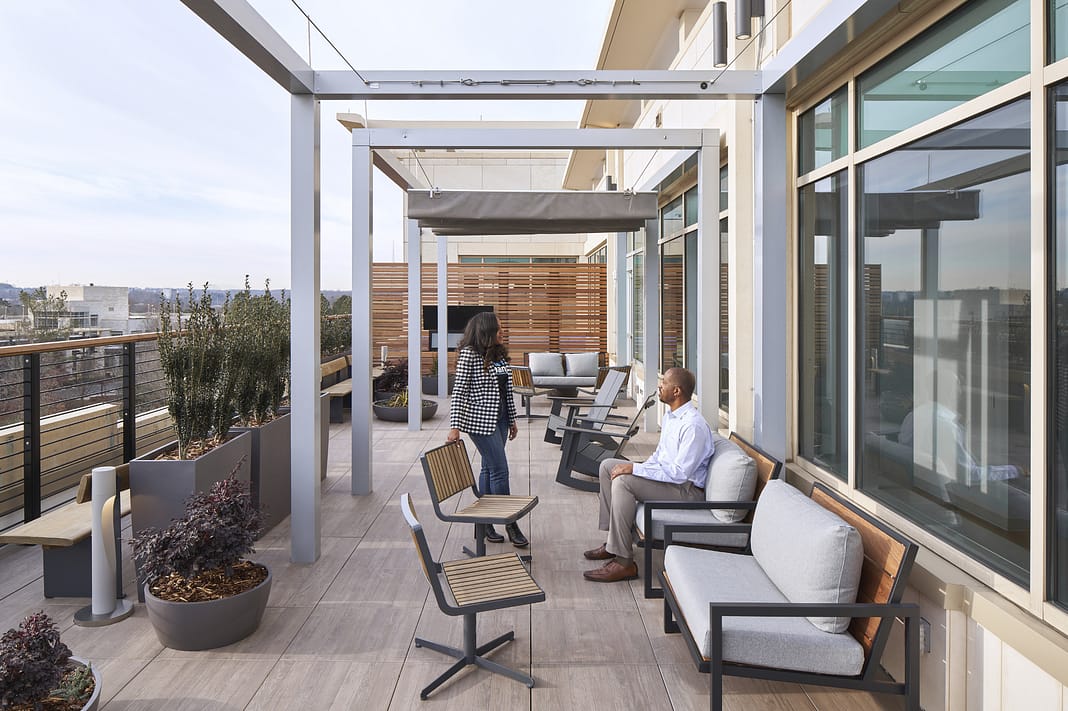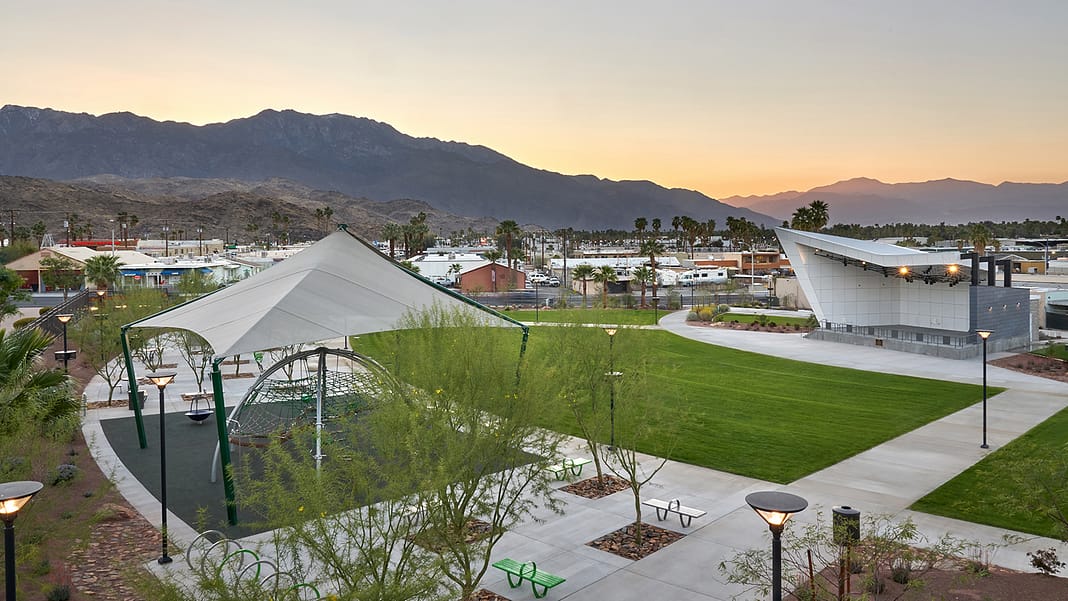By Melissa Panara | Design Director
Lance Wolfson | Project Manager
& Vincent Antkiewicz | Senior Designer
Nature has found its way into the modern office, bringing many benefits through biophilic design to employees and employers. However, the recent trend of bringing the workplace outside has also gained popularity. A stimulating work environment with an inspiring outdoor space has become a new model for the office now and into the future. Spending time outdoors is known to improve both mental and physical health. Providing employees with an opportunity to connect with nature at work can actually benefit their well-being and productivity. Outdoor work environments have the potential to improve employee mood, lower stress levels, increase happiness, and therefore contribute to an organization’s success.
Places for Relaxation

Confidentail Client, Charlotte. Photography © Keith Isaacs
Work-related stress can hinder employee job performance; encouraging employees to spend more time outside is one effective strategy to manage that. Providing an outdoor space can help employees relieve tension, boost job satisfaction, increase overall well-being, and help employers retain and attract talented workers. These benefits translate to better problem-solving, higher engagement, and a workforce that feels inspired, encouraged and supported.

To that end, something new, hammock parks, have seen a rise in popularity. Due to their natural rocking motion, hammocks can help users relax, lower blood pressure, and reduce stress levels. Since getting outside is one of the best ways to clear the mind, relaxing in an outdoor hammock is ideal for decompressing and nurturing mental health. Coworkers are mocking together on their breaks in parks and on campuses. Might those so inclined take their relaxation a step further with floating meditation?
Rooftop patios and terraces are increasingly designed to support individual work, impromptu conversations, casual meetings, and most importantly, relaxation. The incorporation of couches, café seating, and chairs around a fire pit are some of the ways to provide a variety of postures and choices for relaxation or work. Visibility and access from an outdoor workplace to a community café or coffee bar is a welcomed amenity. The goal of such outdoor spaces is to provide an appealing, relaxing atmosphere where employees can escape the hustle and bustle of the workday, enjoy some time to themselves or with colleagues, and come back to the interior space feeling refreshed.
Corporate gardens that encourage staff to pick up a watering can or pruning shears play an essential role in helping to reduce stress levels. Activities related to gardening offer those under pressure a distraction and a way to refocus their attention on something relaxing and good for the environment.
Sometimes the visual stimulation from a well-designed landscape is enough to reduce anxiety and stress. Incorporating moving water into that landscape has multiple benefits for commercial properties and its users, quelling noise pollution while offering the calming effects of running water. Water features contribute to a lowered heart rate and decreased stress. After a long morning of intense meetings, providing employees with the opportunity to go for a walk in natural surroundings (especially those with a water feature), soak up some vitamin D, and come back recharged with a clear head and positive attitude contributes to higher engagement and performance.
Places for Recreation
In response to a challenging young workforce, adaptation to post-pandemic work life, and increasing competition for talent, work environments continue to evolve. Mindful of these factors, employers recognize the imperative to adjust workspaces in ways not traditionally associated with the office. Providing areas for on-site recreational activity is a strategy companies are using to alleviate the demands of work and improve employees’ mental health and physical well-being.
Typically, recreation is seen as the opposite of work, a respite from the daily grind. But an increasing number of companies are taking up the challenge to improve overall quality of life and appeal to a younger workforce. Recreational facilities at the office offer employees the chance to briefly escape and reset their minds and bodies in-house. Incorporating places of recreation can lead to a happier, more engaged staff effectively focused on work. Fortunately, whether the office space is small or a large corporate campus, employers can introduce the idea of recreation as part of the work environment.
Two sports gaining traction among younger professionals are pickleball and disc golf. Both are low-cost and easy to play. Over the past two years, Pickleball has become the fastest growing sport in the United States. Played on a small tennis-like court, a paddle, whiffle ball, and a good pair of shoes are all that is needed. The object is much like tennis with the basic rules being to keep the ball within the court lines and avoid hitting the net. It can be enjoyed by players of any age and skill level. For offices with smaller outdoor areas it can be a great way to offer a recreational outlet, although it must be positioned appropriately to insure balls will not go astray and accidently hit someone.
For workplaces with more outdoor space, disc golf is another sport increasing in popularity nationwide. Following rules similar to golf, it offers the same unique combination of physical effort, outdoor terrain, and sportsmanship found on the golf course, but at a much lower cost, consuming less time, and it is more beginner friendly. Players throw frisbee-shaped plastic discs off a tee pad towards a basket typically consisting of a metal pole driven into the ground, with chains and a metal basket. The only equipment needed are the discs and a pair of shoes with traction. While not all workplaces have room for an 18-hole disc golf course, since disc-golf holes have a range of 150 feet to 1500 feet in length, it is possible to integrate a couple of holes or a putting basket in an underused exterior space, giving employees a chance to be outside and have some fun together. Recently, Good Hops Brewing, in Carolina Beach, NC, for instance, installed a small nine-hole course for patrons and employees to enjoy between brews.

Disc golf baskets are generally a bright color, and are covered in chains to increase the odds that they catch a passing disc.
Other recreation concepts employers are considering include ways to energize older infrastructure without significant expense. A patio at a regional law office was recently renovated into a life-sized exterior gaming area—complete with a checkerboard and life-sized pieces. Another possibility is the creation of an obstacle course alongside an existing walking path, another way to boost physical and mental wellness. For offices with limited space, a small putting green or pickleball court could be the answer.

An outdoor chess set created for a confidential IA client in an outdoor recreation area.
Places for Gathering
Outdoor amenity spaces not only benefit the individual but can improve group cohesion according to research, strengthening company culture. Outdoor dining areas, for example, especially those that provide on-site food preparation, are an excellent way for companies to enhance the employee experience. A space that serves as a dining venue can also be used as an outdoor break room, extra meeting room, collaboration space, touchdown work area for visitors, or place for team building. Outdoor food preparation areas take many forms, including barbecue areas, space for visiting food trucks, access to a food hall, or as a location for brewery/winery-inspired happy hours or company events.

Cathedral City Community Amphitheater, Cathedral City, CA. Photography © Garrett Rowland.
An outdoor meeting area that can support the entire workplace community is another type of amenity space increasingly in demand. Amphitheater-style seating at company campuses can be a great option in areas with mild year-round weather or during warmer months to host town hall meetings, social gatherings, and entertainment, including live music and movie nights for employees and their families that might include the surrounding community.
Final Thoughts
The workplace can be more than just an interior environmental experience. A design that extends the workplace to the exterior provides an opportunity to activate a new set of spaces in ways that can contribute to employee wellness, help people achieve quality of life goals, increase engagement and enhance performance.



